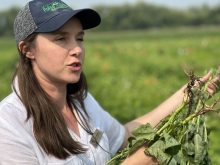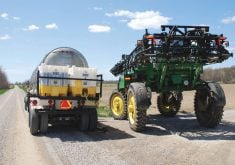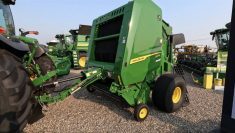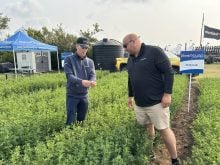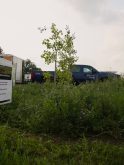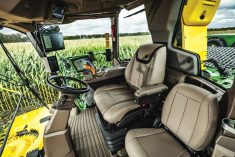WINNIPEG — Earlier in August, Robert Grieger was cutting an alfalfa field on his farm, but then he decided to stop after about 80 acres.
Grieger was concerned because the quarter section was infested with a strange weed he couldn’t identify.
Related story: Watch for noxious tall buttercup and white cockle
Read Also

Saskatchewan puts crown land auction on hold
Auctions of Saskatchewan crown lease land are once again on hold.
There was nothing on his other hay fields. The weed was only on this particular field of alfalfa.
The weed, it turns out, is white cockle.
“I’ve been making hay for 40 years. I’ve never seen this weed in my life. I didn’t even know what it was,” said Grieger, who farms west of Beausejour, Man., where he grows grain, raises 150 cows and has 600 acres of hay production, which he sells to buyers in Canada and the United States.
Grieger confirmed the weed is white cockle by sending a sample to his brother, who forwarded it to experts at the University of Manitoba.
Grieger’s hunch about stopping and not baling the alfalfa was correct.
White cockle might be toxic for livestock.
“People tell me it’s poisonous,” said Grieger, who spoke to the Western Producer Aug. 21.
“If it’s poisonous, I’m not feeding it to my cows.”
After learning more about the weed, Grieger contacted the provincial crop insurer — Manitoba Agricultural Services Corp. — to make a claim regarding the infestation of white cockle.
If he can’t harvest the quarter section of alfalfa, it could represent a loss of $150,000 because he sells hay to high value markets such as dairies and exports forage to the U.S.
MASC has denied his claim.
“They don’t want to give me any compensation, even if it is poisonous, because they don’t cover weeds,” he said.
“For crop insurance, if they paid me out, I think I would get $50,000 to 60,000….This field should be taken out of production. They shouldn’t (ask) me to bale it, or anything like that.”
Is white cockle poisonous, or not?
After Grieger contacted the provincial crop insurer, Kim Brown got involved in the case.
She is the provincial weed specialist with Manitoba Agriculture.
MASC asked her to do some research on the weed because this issue with white cockle is bigger than Grieger and his quarter section of alfalfa.
Several farmers in Manitoba have infestations of the weed, and they’re reluctant to harvest their hay crop, Brown said.
She hasn’t found a definite answer.
“I don’t know whether it is or not (toxic). We don’t know. I can find some references, but they’re not scientific references,” she said.
“I don’t know how toxic it is. Our provincial vets are looking into that. I also have polled my colleagues with Agriculture Canada and in Saskatchewan…. As yet, I haven’t had any answer back.”
The Alberta Agriculture website does have information on cow cockle, a weed that’s very similar to white cockle.
“The leaves and seeds of cow cockle are poisonous to livestock,” the website says.
“One hundred and twenty-two grams of cow cockle seeds per 45 kilograms body weight is reported to cause death.”
The information from Alberta may be accurate, but that doesn’t help Brown or Grieger.
Cow cockle is not the same as white cockle.
“There are four weeds that are very closely related. There is cow cockle, white cockle, night flowering catchfly and bladder campion,” Brown said, adding the plants are part of the pink/carnation family.
“I don’t know whether you could assume that everything in that family is as toxic (as cow cockle).”
Another source from Alberta, the Alberta Invasive Species Council, has a fact sheet on white cockle. It says the weed can be problematic for forage seed production because “its seeds are difficult to separate from alfalfa, clover and some grass crop seeds.”
There’s no mention of toxicity in the factsheet.
Meanwhile, as Brown and others look for answers, Grieger still has a half-cut field of alfalfa that’s infested with a possibly toxic weed.
Baling up the weedy forage and feeding it to his cattle isn’t worth the risk. And he can’t sell the hay, either.
Grieger, though, does have a theory on how the white cockle appeared on the quarter section of hayland but not the other fields on his farm.
Thousands of geese were on the field this spring and they possibly deposited the weed seeds.
“The first 100 feet (of the field), there are no weeds. As you get past that, it gets a little bit more. In the middle, it’s worse,” he said.
“I’m 99 percent sure it got in there (from) the geese.”
Grieger has crop insurance for his hay production, which covers volume, quality and wildlife damage. He believes the weed infestation should quality as wildlife damage.
“There (were) thousands of them in there. What am I supposed to do?” he said.
“They (MASC) tell me I have to prove that.”
In an email to the Western Producer, a MASC spokesperson said its Agri-insurance program covers production shortfalls and quality losses from natural perils.
“Weeds and other management-related causes of loss are uninsurable under the Agri-Insurance contract,” the email says.
“MASC completes appraisals of production to determine the amount to be included in a claim calculation, and it is always up to the producer to decide if they harvest or not. If a producer disagrees with MASC’s appraisal, they have the option to file an appeal with an independent Appeal Tribunal and are welcome to pursue this option.”
Contact robert.arnason@producer.com






